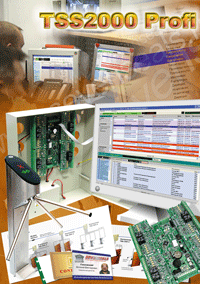
Network ACS of Russian production.
The two previous issues of TZ published a review of access control and management systems from leading foreign manufacturers. It was no coincidence that we started with foreign equipment, because, in fact, the formation of this segment of the Russian TSB market began with imports. Then, at the end of last year, we decided not to order a preliminary review from one author, but, having interviewed several experts, made an editorial based on their opinions.
We approached the preparation of the material on Russian access control and management systems in the same way. Why did network ACS become the topic of our latest review? Firstly, the offer formed by the Russian market today is really very diverse. As one of the most authoritative experts on the market, Leonid Stasenko, once said, today almost anyone can make an autonomous controller that will work at least somehow. And many people do it. It seems understandable that we want to narrow the topic a little, firstly, to fit the article into a framework that is more or less acceptable for a magazine format. And secondly, network access control and management systems integrated with other integral components of modern technical security means are not only the right “today”, but also the only promising “tomorrow” of the industry.
Market View
Experts are almost unanimous: in the segment of access control and management systems, the share of Russian products is no less than 50 percent. Some analysts also classify intercoms as ACS, and then this share increases significantly. Some argue with this approach, believing that intercoms can be classified as ACS only by formal criteria, but in reality they occupy a separate niche in the market. The point, you understand, is not in this. At least half of the market, and this is a serious figure. It is even more significant if you consider that some 15 years ago, there were practically no Russian-made ACS at all.
Yes, the first products (these were usually readers compatible with the most common Western equipment in Russia at that time) were often assembled right in the offices, as they say, on the knee. But the result is even more impressive. Today, leading Russian manufacturers produce systems that are not inferior to their foreign «classmates» in terms of functionality, quality and reliability. Assembly plants have all the necessary certificates, they use the most modern technologies for assembling radio-electronic devices. Output control of all products without exception is ensured, and complaints amount to fractions of a percent.
These are the most complex network ACS, in fact, complexes that, in addition to display functions, settings of the same controllers, include many functions related to the operation of the database. These are personnel databases, and time schedules, work logic, and various schedules, and systems (and quite powerful ones) of report generators, and accounting of working hours. Let's not forget about video verification, numerous service functions, such as, for example, printing on plastic cards, the antipassback function.
And, of course, almost all the systems that dominate the market are integrated with other components of technical security systems. Moreover, it should be noted that this is an achievement of literally the last three to five years. Until recently, the integration of ACS with other systems was a good PR move for some manufacturers and, at the same time, an indicator of the «coolness» of the customer. Today, it is entirely legitimate to say that a reasonable and justified demand for such systems has already been formed. And along with it, specific customer requirements.
Who is the customer? All experts interviewed during the preparation of the article, without collusion, showed complete unanimity in answering this question: the consumer of Russian developments is very diverse, from industrial enterprises and shopping centers to private buyers. At the same time, the desire of customers to optimize costs while maintaining quality was noted as the main trend dominating the market today. Moreover, this dominant trend arose long before the crisis.
As a rule, the consumer gives preference to the Russian developer in those projects where competent consultation at the design stage and qualified technical support at the stage of equipment deployment and operation are required. In this case, the proximity of the manufacturer and the ability to influence it in many cases become decisive factors in the choice.
How much is Russian in them?
It is unlikely that you will find a system on the market that was created from scratch among the birches of the Moscow region. Not only ACS manufacturers, but the entire Russian security industry took foreign-made equipment as models. This is a completely objective fact that no one has ever intended to hide. Access control and management systems were created long before Russia entered the market and, therefore, mass demand for such systems. And the first Russian readers were more or less successful copies of Western analogues. But we must admit another thing: no one in the world will invent something that has already been invented, produced and works. It is the same as trying to optimize the shape of a wheel or trying to put a racing car on tracks. Therefore, there is only one way: taking the best as a basis, adapting it as much as possible to the conditions of the upcoming operation and moving in line with the leading trends in the development and improvement of equipment.
Moreover, the international division of labor has long ago «internationalized» almost any production. Outsourcing today is a global phenomenon, and the same microcircuits of an American developer company are made somewhere in Malaysia, printed circuit boards can be assembled even in Turkey, plastic will be molded in China, and so on.
But the final product is not a handful of microcircuits. It is, first of all, algorithms, circuitry and software. It is this superstructure over the assembly that determines the product, its consumer qualities. With this approach (and it is impossible to dispute it), Russian developments are almost 100 percent domestic.
The products of many Russian developers are manufactured and assembled using the same technologies and often in the same factories as the products of leading global manufacturers. And just as there is a lot of excellent and reliable equipment among domestic products, there is also a lot of defective equipment among imports (especially cheap ones). The opposite is also true. It is encouraging that our developers and manufacturers are constantly making efforts to improve the competitiveness of the manufactured TSB — otherwise, they simply cannot survive.
Pros and cons
The advantages of the best Russian developments are obvious: truly high quality and reliability, proven by many hundreds of installations and years of intensive operation at sites of varying complexity. Due to the geographical proximity to the customer, our manufacturers have much more opportunities than their foreign colleagues to organize normal technical support. Those who use this opportunity wisely receive an obvious competitive advantage. We must not forget that the best Russian ACS are fully adapted to operating conditions. And this is not only the harsh climate of the Russian expanses, but also the state and capabilities of electrical networks, IP communications, the still far from ideal level of training of installers and operating services. Finally, the pronounced tendency of a large part of the population to vandalism — this, you must agree, also cannot be ignored.
The next factor that often becomes decisive when choosing a system is the relatively low price. Most Russian ACS occupy the average price niche, which, combined with high quality, largely explains the significant market share they occupy.
Of course, there are also disadvantages. At very large distributed sites, foreign equipment still dominates. Such sites require a certain set of system characteristics, which Russian developments cannot always provide yet. The reason is obvious and objective: we do not have 20 years of experience in the production and operation of such systems, the threshold for the transition from quantity to quality has not been overcome, because the Russian TSB market is still very young.
It is also true that Russian-made ACS do not appear in the corporate standards of leading Western network structures. Despite their obvious success in Russia, our developers have not become participants in the global market. Again, not yet.
And this is not because Russian ACS are not worthy of being represented there. It is just that entering the world market is a long and difficult path, which is difficult to overcome even for a very large company without the participation and assistance of the state. In our country, even simply establishing export of products is a huge problem. Even if there are specific orders.
There are practically no Russian-made ACS in the elite systems segment. The creation of such equipment requires huge investments, which most Russian companies simply cannot afford at the moment. Will the situation change in the future? It is difficult to say. It is possible that our developers, forced by many objective and subjective reasons to focus on the mass consumer, will leave this narrow segment to their Western colleagues.
In the review part of the publication, readers will be able to familiarize themselves in detail with the description and technical characteristics of some of the Russian-made network ACS presented on our TSB market.
Access control and management system TSS2000 Profi («Seven Seals»)
The software part of the TSS2000 Profi ACS is a set of modules interacting via the TCP/IP protocol on the client-server principle. The core of the system is implemented as Windows services. DBMS — Firebird.
The number of key codes is unlimited (standalone mode — 65,025). The event log size is unlimited (standalone mode — 250,000). The number of access routes is unlimited. The number of schedules is unlimited (standalone mode — 16).
The TSS2000 Profi ACS can be built as a local system with three ways of connecting the equipment: directly to the ACS server, to equipment servers, via LAN (the number of controlled checkpoints is from 1 to 2032). The second option for building is a distributed system with synchronization of databases of an unlimited number of local ACS (including via slow communication lines), which allows maintaining a single system for registering personnel and generating reports on working hours (the number of controlled checkpoints is unlimited).
The system (in addition to the core and administration programs) includes the modules «Pass Bureau», «Checkpoint», «Work Monitoring» (in text and graphic form), «Reports». Additional software: «Creating and Printing Passes», «Work Time Accounting», «Visitor Registration», alarm system, video surveillance system, integration with external security systems, data import/export system.
. IP-ACS Tempo Reale (OJSC NPP Alfa-Pribor)
Tempo Reale is a universal system based on APDA series controllers and designed to manage subscriber access in accordance with assigned rights, automated accounting of working hours and control over labor discipline.
Due to the architectural features of the Tempo Reale ACS as an IP solution, its reliability, high throughput, rapid deployment at the facility and easy scaling are ensured.
The APDA series controllers can be used both in stand-alone mode and as part of a network access control system controlled by Tempo Reale software. APDA.21 and APDA.41 are designed to connect up to 2 and 4 readers with a Weigand interface, respectively, and provide control of actuators of various barriers (doors, gates, turnstiles, airlock cabins, etc.).
Due to the presence of additional inputs and outputs, APDA controllers allow implementing a wide variety of access modes and algorithms for system response to emergency situations (event relationships).
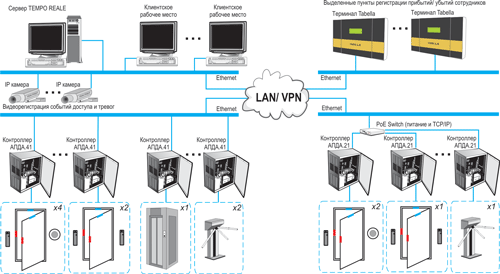
An undoubted advantage of APDA controllers is the presence of an Ethernet network port, which allows building geographically distributed systems with the ability to remotely monitor and control devices included in the system.
The new IP controller APDA.21 deserves special mention. For the first time in Russian-made systems, the organization of re-entry control (anti-passback) and event connections is carried out at the controller-to-controller level, which increases the reliability and fault tolerance of the system when communication with the central server is lost. In addition, the developers equipped APDA.21 with internal memory for 20,000 cards and 30,000 events and the ability to power over Ethernet (PoE).
The software component of the system – Tempo Reale software – is a client-server solution that provides the user with the ability to monitor events in the system in real time, directly control the ACS equipment, automate the accounting of working hours, including the creation of more than 20 types of reports and a unified time sheet in the form T-13.
At the software level, the Tempo Reale IP ACS supports integration with AXIS IP cameras, which allows video verification of subscriber access to controlled areas and recording of video fragments corresponding to system events.
GATE Access Control and Management System («Ravelin»)
The GATE ACS is a flexible, easily scalable hardware and software complex based on GATE-4000 controllers, one or more computers with specialized software, readers, executive and external devices.
The GATE ACS was created as a universal system that has various areas of application: offices in business centers, industrial enterprises, educational institutions, parking lots, canteens of large enterprises, sports complexes. The GATE system is a designer with enormous potential and is capable of solving problems of varying degrees of complexity.
The GATE ACS is simple and convenient (the system is based on a single standard controller), and remains operational in the event of a computer failure or communication loss. The flexibility and scalability of the system make it possible to freely expand it if necessary. The system can be integrated (Intellect, Essel, Laguna, 1C, etc.), and has a European quality certificate CE.
The system consists of GATE controllers (up to 255 in a line), a computer with specialized software, readers (HID, EM-Marine, Mifare, radio key fobs), actuators (locks, turnstiles, barriers, etc.)
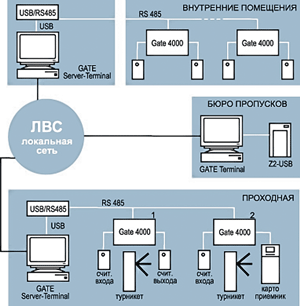
GATE capabilities include up to 8144 users and up to 7 schedules for each access point, a local buffer for 4095 events in each controller (events are not lost if the connection is lost), and saving all events on the computer.
The system generates reports, has a direct control function from the computer, and monitors current system events in real time. There are also functions for issuing temporary passes, supporting photo verification, and organizing remote workstations.
GATE software is designed for:
System settings and configuration.
Defining controllers, readers and schedules.
Working with passes, changing access rights.
Real-time monitoring.
Control over movements.
Reading events from the controllers' memory and saving them to the computer.
Receiving reports.
Accounting for personnel working hours.
Photo verification.
Control of remaining employees.
ACS «Kronverk» (ACS)
The Kronverk ACS is designed to meet all requirements for a modern access control system.
The Kronverk ACS allows:
Connecting Kronverk system controllers to the facility's Ethernet network.
Determining the location of employees and guests within the entire facility.
Autonomous change of access mode for individual rooms.
Organizing work time accounting with the formation of a standard timesheet.
Interaction with software applications of the enterprise's HR department — employee data entered in the HR department is automatically entered into the ACS database.
Programming automatic responses to events occurring in the system (automatic change of the operating mode of individual access points by event and by time, performing actions on commands from other systems deployed at a given enterprise).
Integration with fire alarm systems and security television systems.
Synchronization of databases with business applications.
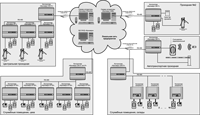
The hardware of the Kronverk ACS is represented by industrially manufactured system controllers. The special feature of the Kronverk SM-01 isp. E system controller is the direct connection to the Ethernet computer network. The Kronverk controllers have a certificate of conformity ROSS RU.OC03.B01317, issued by the Federal State Institution «CSA OPS» of the Ministry of Internal Affairs of Russia. The equipment is provided with a 12-month warranty.
The Kronverk Professional software is freely available (on the Internet or on disks with accompanying documentation for the Kronverk ACS system controllers), the number of workstations is replicated in accordance with the customer's requirements without additional payment.
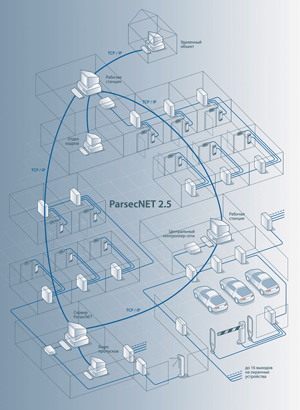
Integrated system ParsecNET 2.5 («RELVEST»)
The system is capable of providing security at facilities of various sizes — from a small office to a large enterprise. In addition to access control, the system provides support for the security alarm function and integration with digital video surveillance, which allows for comprehensive protection of the facility without the use of additional means.
A distinctive feature of the new version of the software is the almost completely redesigned core of the system. The ever-increasing scale of systems and their distribution require higher speeds and reliability in the transmission and processing of information. The changes affected both the mechanisms for transmitting data over a local network and the internal algorithms for processing and responding to system events.
The transition to the client-server MS SQL DBMS ensures the required speed of processing and presenting information (primarily this concerns reports and remote access to the system database). Equipment with an Ethernet interface can be used to unite geographically remote segments of the system. These devices allow for the unification of remote objects without laying additional communications if there is a local network between them.
The range of equipment in the system has been expanded with a new line of controllers with DIN rail mounting, which simplifies the installation of controllers in office premises where electrical cabinets already exist.
ParsecNET 2.5 software has a powerful timekeeping system with flexible customizable rules for calculating hours worked. If it is necessary to adapt the output report forms to customer requirements, the new version of the system provides the user with a toolkit that allows for the quick and easy creation of any custom forms for the resulting reports. Several standard forms are supplied with the system, but if the customer is not satisfied with them, he can create any number of his own forms.

Добавить комментарий